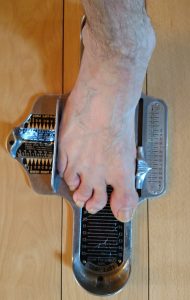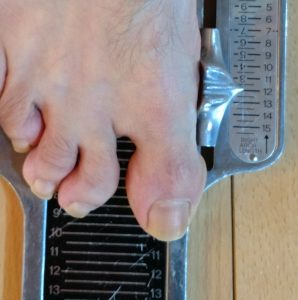Are you one of those people who get home and immediately kick your shoes off–possibly sending them across the room? Wouldn’t it be nice to get home from work and forget that you even have shoes on? I’ve been there and over the years have learned the underlying message behind this behavior–your body is exhausted by the effort it takes to balance in shoes that do not fit your feet.
Foot movement is managed by the muscles of the lower leg via their attachment on the foot. The key role of these muscles are to balance, direct weight and propel the foot. First, the balancing muscles (including the shin muscle-tibialis anterior) attached to the arch, lifts the arch of the foot and then, the posterior tibialis (a muscle on the back of the shin-which is also attached to the arch) eases the weight transfer as it engages the arch to spring and shock absorb. This action initiates the calf muscles (gastrocnemius and soleus) to contract and direct weight to the toes. The springing action of the arch and the big toe (called the Hallux-which means spring) propels the foot forward. It’s a beautiful, synchronistic action that your body depends on to get from here to there.
Here’s the snafu—these muscles can get confused by the shoes we wear. Once we change the neutral position of the foot such as lifting the heel or when foot muscles are required to hold a shoe on (such as a flip flop), their muscular function become distorted and they lose their power to move the foot effectively. This in turn demands another part of the body to engage to assist in balancing and moving the body– this becomes excessive on muscles that are not designed to function this way as they become drenched with fatigue.
Here are some tips for happier feet and bodies:
1.Be sure the shoe fits your foot.
- Have someone trace your feet while you stand. Cut the drawing and place it in your shoe. The drawing will show how your foot rests in this shoe. How much does your foot have to fold and bend to fit into this shoe?
2. Take all 3 measurements of each foot with a Brannock Measuring Device: The toe-to-heel, the ball-to-heel, and the width (the ball-to-heel is measured by placing the knob against the ball of the 1st toe).


- As the images show, most people have a longer arch measurement (ball-to-heel) than the length from their toe-to-heel. In these cases the arch length is the size shoe required to fit the foot comfortably.
3. As often as possible, choose a shoe that allows your foot to relax completely in a neutral position.
- This may take some time to get used to–especially if you have become accustomed to wearing heels or flip-flops.
4. If you have been wearing shoes that are less than functional–do some calf stretches.
- Gently, place the balls of your feet on the edge of a stair. Be sure to look straight ahead and not at your toes. Lift your heels up for 2 seconds and lower your heels below the stair tread for 2 seconds. Start out with 5 repetitions and build up to 10 repetitions a day-barefoot.
5. Practice walking barefoot in the house- preferably without socks.
- This is the ultimate exercise to help the muscles of the foot to recover from distortions placed against their function-and to increase their strength. If you are not accustomed to going barefoot, take your time and don’t over-do. You wouldn’t spend hours at the gym working out all day for the first time.
Ideally, your over-all well being would improve if you could kick-this habit of wearing high heels and/or flip-flops as your daily shoe, but I also understand there will be those who are not ready to make that leap.
I am excited to hear about your progress! Please let know if you have any questions.
Cheers to improving the health of your feet and body!
Geraldine
3 Responses to Tips to prevent foot pain.
Leave a Reply Cancel reply
Archives
- October 2024
- December 2023
- October 2023
- March 2022
- July 2021
- August 2020
- May 2020
- April 2020
- February 2020
- January 2020
- December 2019
- November 2019
- October 2019
- August 2019
- June 2019
- May 2019
- April 2019
- January 2019
- December 2018
- October 2018
- September 2018
- July 2018
- June 2018
- April 2018
- February 2018
- December 2017
- November 2017
- October 2017
- September 2017
- August 2017
- July 2017
- June 2017
- May 2017
- April 2017
- February 2017



Pingback: Release tension causing tarsal tunnel syndrome and iliopsoas tightness « Put Your Best Feet Forward